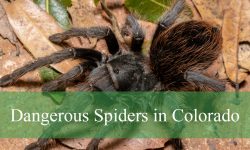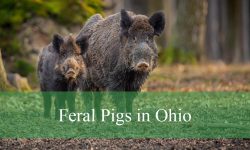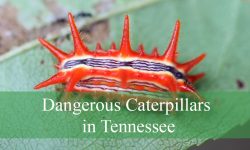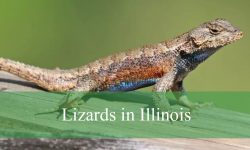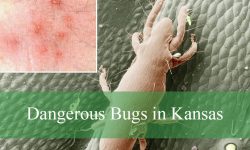Birds with orange chests add a vibrant splash of color to their surroundings and attract birdwatchers and nature enthusiasts alike. These feathered wonders, boasting vivid hues ranging from fiery oranges to warm yellows, are found in various habitats around the world. From tropical rainforests to open grasslands, they bring brightness and beauty wherever they go.
Let’s explore the fascinating world of birds with orange chests and discover the diversity they bring to our skies.
Different Types of Birds with Orange Chests
Blackburnian Warbler
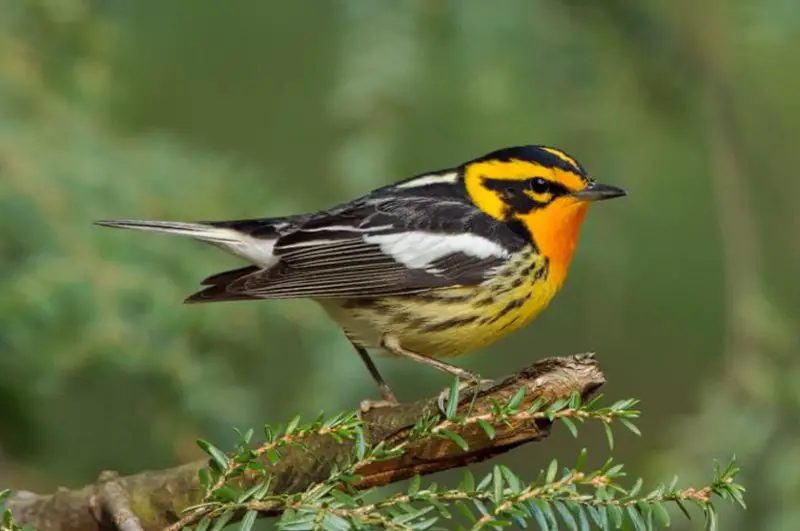
The Blackburnian Warbler (Setophaga fusca) is easily distinguished from other songbirds in North America by its vivid orange throat and chest set against sleek black plumage. It migrates to the mountain forests of South America in the winter after breeding in the boreal forests of North America during the summer.
It is well-known for its beautiful melodies, which fill the woods, especially in the early morning hours. The Blackburnian Warbler is a magnificent bird of nature, measuring 4.5–5 inches (11–13 cm) in length, 0.3–0.4 ounces (9–12 g) in weight, with a wingspan of 7–8 inches (17–20 cm) and a lifespan of 5–8 years.
Summer Tanager
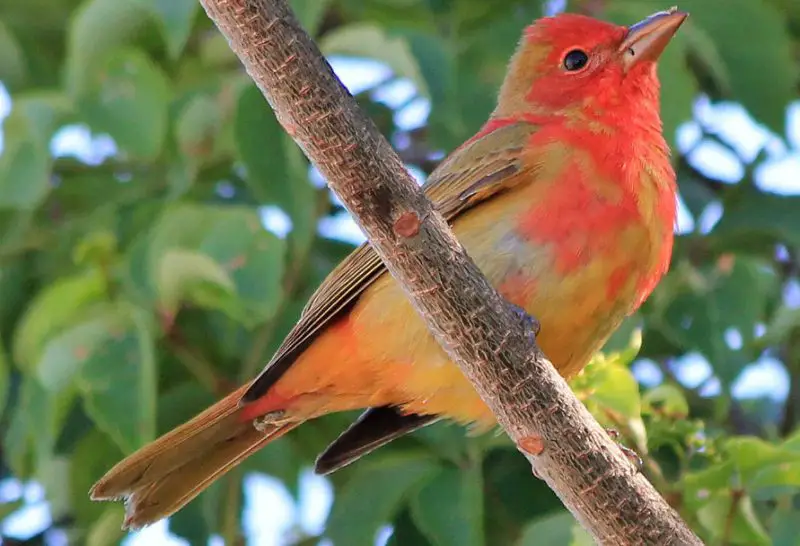
The Summer Tanager (Piranga rubra) is a striking orange bird synonymous with the southern summer landscape of Northern America, thanks to its reddish-orange hue. Males boast vibrant red plumage, while females sport a camouflaging yellow shade. Found in open woodlands, parks, and gardens, they feast on insects, fruit, and nectar.
Their varied songs resonate through their habitats. Nesting on hidden horizontal branches, they epitomize nature’s artistry. With a length of 6–7 inches (15–18 cm), a weight of 1.0–1.3 ounces (28–37 g), a wingspan of 11–12 inches (28–30 cm), and a lifespan of 8–12 years, the Summer Tanager embodies the beauty of the season.
Painted Bunting
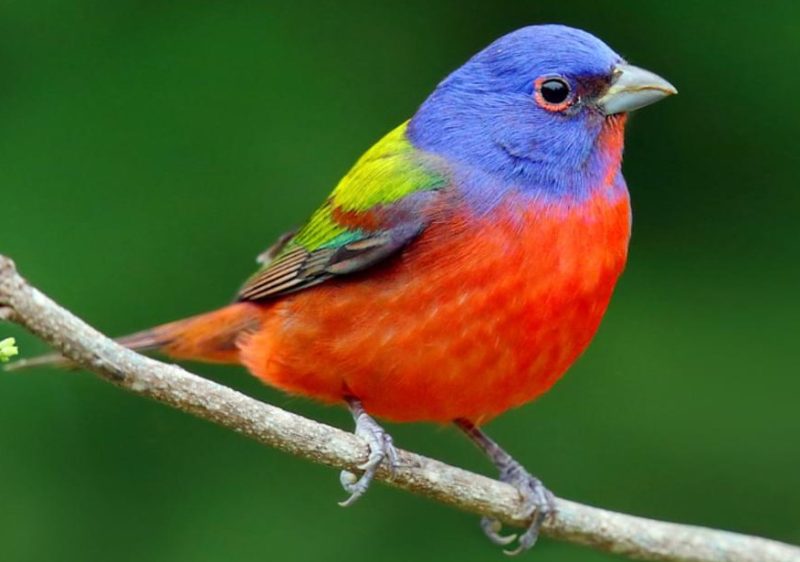
The little songbird known as the Painted Bunting (Passerina ciris) is well-known for its vividly colored plumage. While female buntings are green and yellow-orange in color, males have startling blue heads, green backs, orange chests, and brilliant red underparts. They eat seeds, fruits, and insects, and they like dense shrubs on the margins of forests. Birdwatchers may find it difficult to observe these cautious and elusive birds, despite their diverse vocal repertoire.
During mating season, males perform elaborate courtship displays to attract mates, while females build concealed nests of grass and leaves within dense vegetation. It measures 4.5–5 inches (11–13 cm) in length, 0.5–0.7 ounces (14–20 g) in weight, 7.5–8.5 inches (19–22 cm) in wingspan, and has a 3–5 year lifespan.
Northern Cardinal
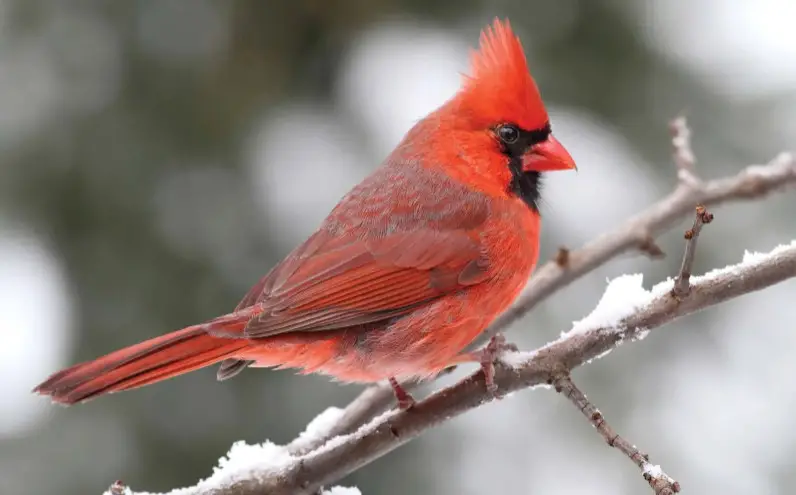
With its striking dark orange plumage and unique crest, the Northern Cardinal (Cardinalis cardinalis) is a well-known bird in North America. At 8 to 9 inches (20 to 23 cm) in length, 1.5 to 1.8 ounces (42 to 51 g) in weight, and with a wingspan of 9.5 to 12 inches (24 to 30 cm), a lifespan of 15–20 years, it is a regular sight in parks, gardens, and wooded areas, captivating birdwatchers with its melodic songs.
During the breeding season, they participate in courting feeding and develop close ties with their partner. They are monogamous. Nesting in low, dense bushes or trees, they play an important role in controlling insects and spreading seeds, which helps maintain the equilibrium of the ecosystem.
Flame-colored Tanager

With its vivid orange-red plumage, the Flame-colored Tanager (Piranga bidentata), which is 5.5–6 inches (14–15 cm) in length and weighs 0.4–0.6 ounces (11–18 g), stands out in its natural habitat. While females have more subdued yellow-green hues with a tinge of orange, males have more vibrant colors.
Their lovely, melodic songs reverberate throughout the forests, and they prefer fruit and insects. They live in South America’s high-altitude forests, particularly those of the Andes mountain range, and are highly valued by birdwatchers for their contribution to the region’s abundant biodiversity.
Black-headed Grosbeak
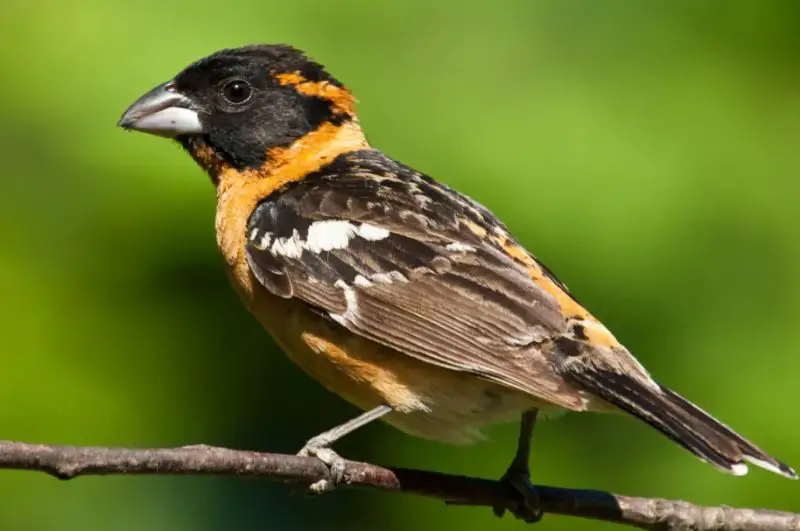
The Black-headed Grosbeak (Pheucticus melanocephalus) is a bird species found in North America during warmer months. Males flaunt striking black head and neck feathers contrasting with vibrant orange and black plumage, while females display subtle yellow-brown hues. Preferring open woodlands, gardens, and parks, they feed on seeds, insects, and fruits. Known for their sweet, varied songs, they nest on horizontal tree branches.
With a length of 7.5–8.5 inches (19–22 cm), a weight of 1.0–1.1 ounces (28–31 g), a wingspan of 12.2–13.4 inches (31–34 cm), and a lifespan of 5–8 years, the Black-headed Grosbeak enriches North America’s avian diversity.
Varied Thrush
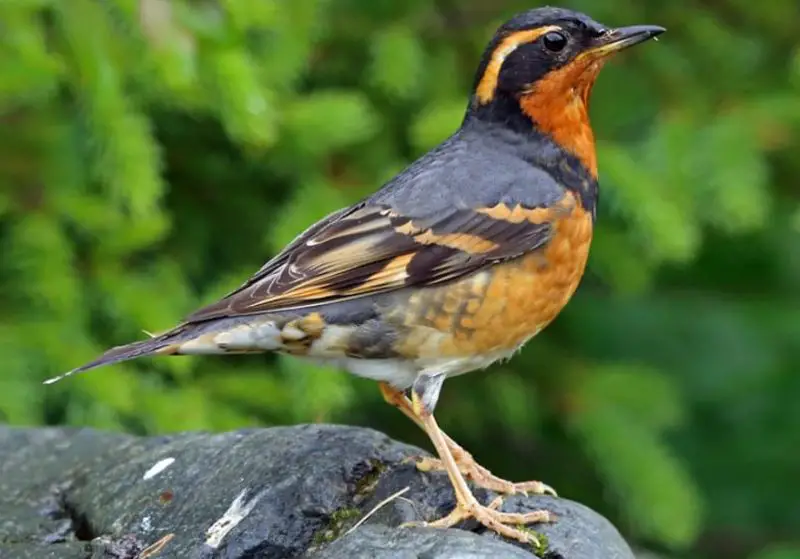
Birdwatchers appreciate the Varied Thrush (Ixoreus naevius) for its magnificent plumage of vivid orange and black. They have a wingspan of 14.2–15.8 inches (36–40 cm), a length of 8.5–10 inches (22–25 cm), a weight of 2.1–2.5 ounces (60–71 g), and a lifespan of 4-5 years.
They are typically found in damp coniferous woods along the Pacific coast. They eat seeds, berries, insects, and horseshoe crab eggs. Males sing loud, catchy songs to entice females during breeding. They add to their mystique by migrating southward during the winter and making their nests on the ground beneath thick vegetation.
Rusty Blackbird
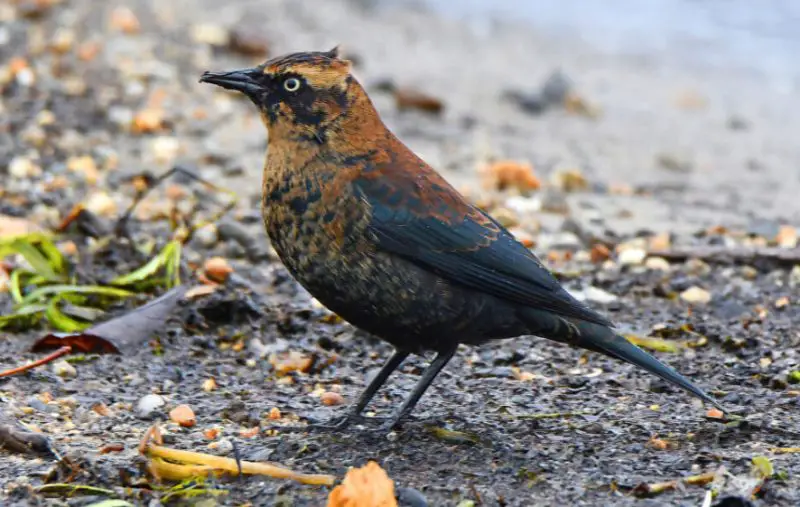
In North America, the Rusty Blackbird (Euphagus carolinus) is a common sight, mostly found in marsh environments. They weigh 1.6–2.2 ounces (45–62 g) and are 8.3–9.8 inches (21–25 cm) long. They eat berries, seeds, and insects. Their distinctive feathers vary in color from dark orange to black, with brilliant yellow eyes to contrast.
Males sing beautiful, intricate songs and display social behavior during courtship, frequently foraging in groups. Despite their popularity, habitat degradation and other factors are causing their population to decline.
American Redstart
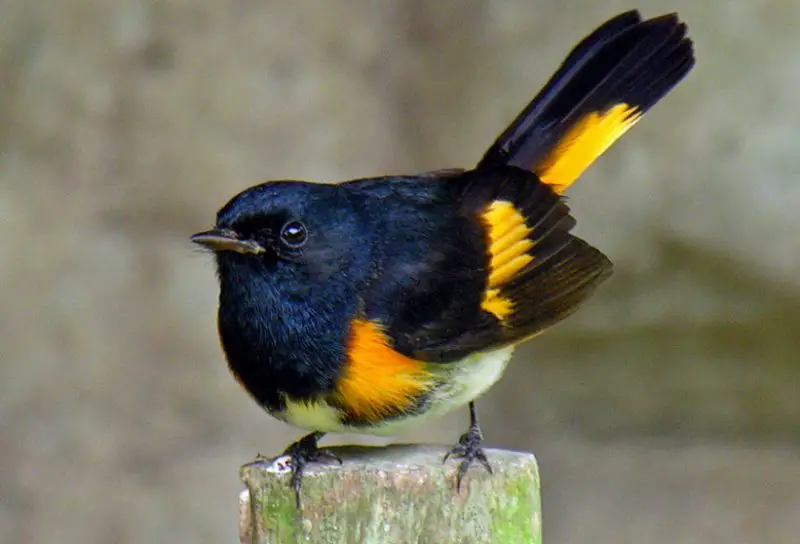
The American Redstart (Setophaga ruticilla) is a small, brightly colored warbler found across North America, renowned for its striking orange and black plumage. It forages insects by flashing its wings and tail feathers. Preferring deciduous and mixed forests for breeding, it builds cup-shaped nests in tree trunks. With a length of 4.3–5.1 inches (11–13 cm), a weight of 0.2–0.4 ounces (5–12 g), and a wingspan of 7.5–9.1 inches (19–23 cm), it lives 3–6 years.
Its high-pitched, musical songs are heard during breeding, and it migrates to Central and South America for winter. Admirable for its acrobatics in catching insects mid-air, the American Redstart captivates birdwatchers with its unique hunting techniques.
Chestnut Weaver
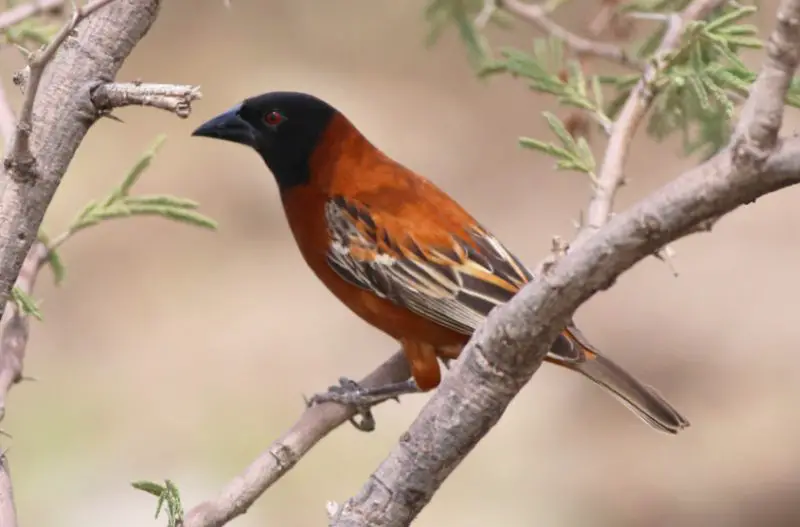
The Chestnut Weaver (Ploceus rubiginosus) is a small, striking bird native to parts of Africa, known for its distinctive chestnut-colored plumage. Often found in flocks, they forage on insects and seeds in grasslands and savannas. Their intricate, woven nests, crafted from grass and other plant materials, hang from trees in basket-like shapes.
Monogamous breeders, they reproduce during the rainy season. With a length of 5.9–6.3 inches (15–16 cm), a weight of 0.7–0.8 ounces (20–24 g), and a wingspan of 9.8–10.6 inches (25–27 cm), they have a lifespan of 3–4 years.
Altamira Oriole
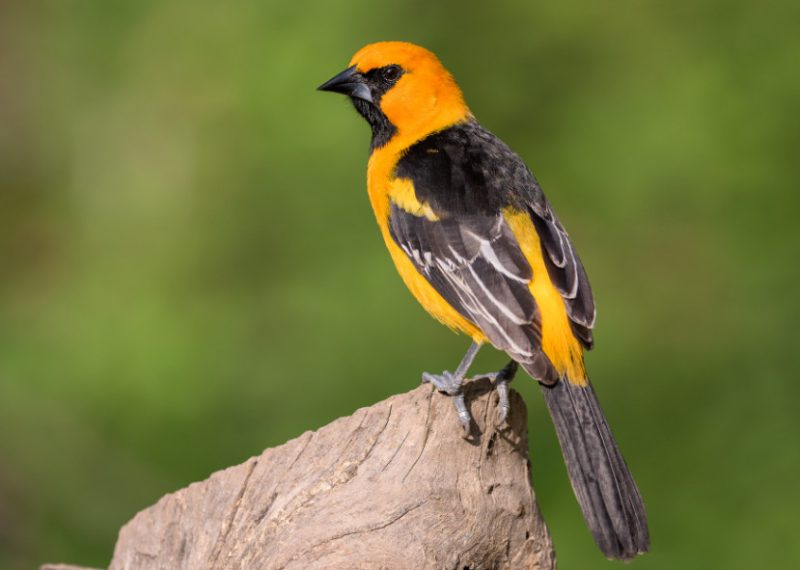
The Altamira Oriole (Icterus gularis) is a visually striking bird with its vibrant orange chest, captivating bird enthusiasts. Found primarily in southern Texas and parts of Mexico, they inhabit riparian areas, woodland edges, and open forests. Known for their melodic songs of clear whistles and trills, they are highly social birds often seen in pairs or small groups.
Feeding mainly on insects, they also consume fruits and nectar, particularly during the breeding season. With a length of 9.1–9.8 inches (23–25 cm), a weight of 2.5–2.9 ounces (70–82 g), and a wingspan of 12.6–13.8 inches (32–35 cm), they have a lifespan of 5–8 years.
Orchard Oriole
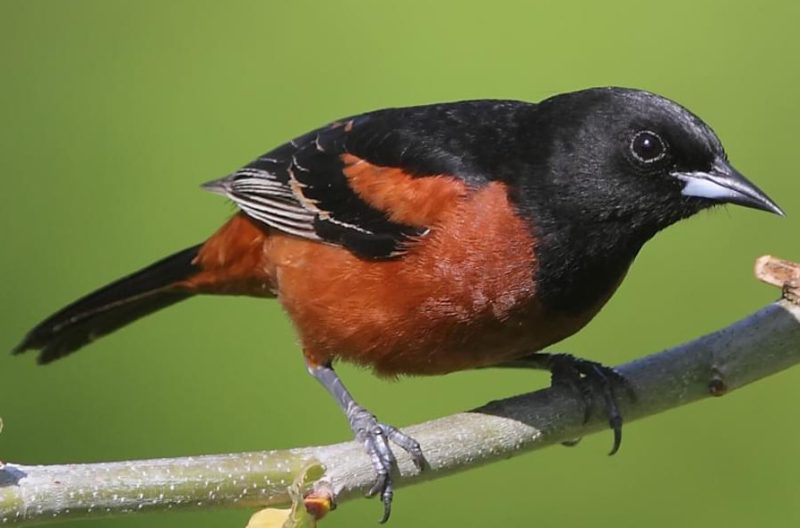
The Orchard Oriole (Icterus spurius) is a small, brightly colored bird known for its orange chest and distinctive white wing bars against black feathers. Found in woodland edges, parks, and gardens, they build their nests in these habitats. With a varied diet of insects, nectar, and fruits, they play a vital role in maintaining ecosystem balance.
Orchard Orioles have a lifespan of 5–7 years and measure 6.7–7.5 inches (17–19 cm) in length, weighing 0.8–1.1 ounces (23–31 g), with a wingspan of 10.2–11.0 inches (26–28 cm).
Red-bellied Woodpecker
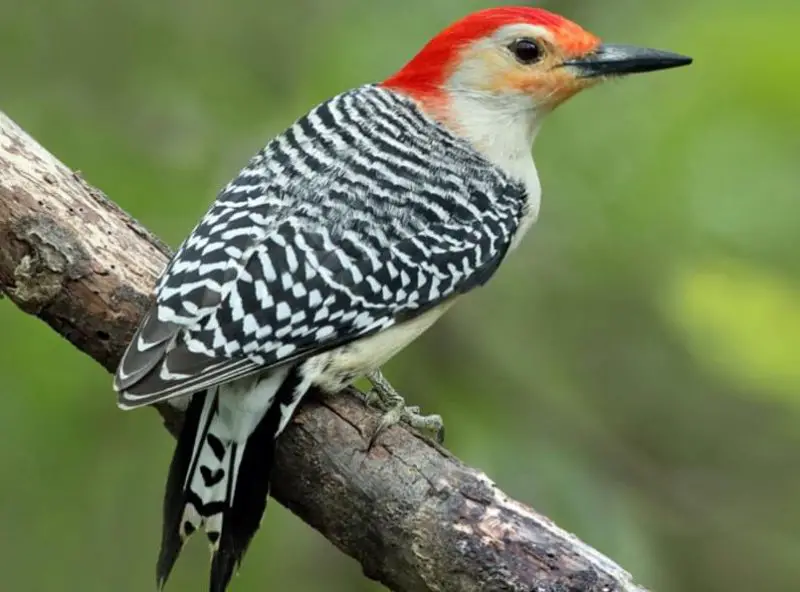
The Red-bellied Woodpecker (Melanerpes carolinus) is a medium-sized bird, measuring 9.0–10.6 inches (23–27 cm) in length, with a weight ranging from 2.0 to 3.9 ounces (57–110 g). Its wingspan spans 13.0–16.5 inches (33–42 cm), and it typically lives for 9–12 years. This species is easily identified by its striking red cap and orange chest, with females displaying red only on their necks and bill bases.
Found throughout the eastern United States in various habitats, including forests, suburbs, and parks, they are omnivorous, consuming insects, fruits, and seeds. Red-bellied Woodpeckers communicate using varied calls and drumming sounds and are skilled at excavating tree cavities for nesting.
African Stonechat
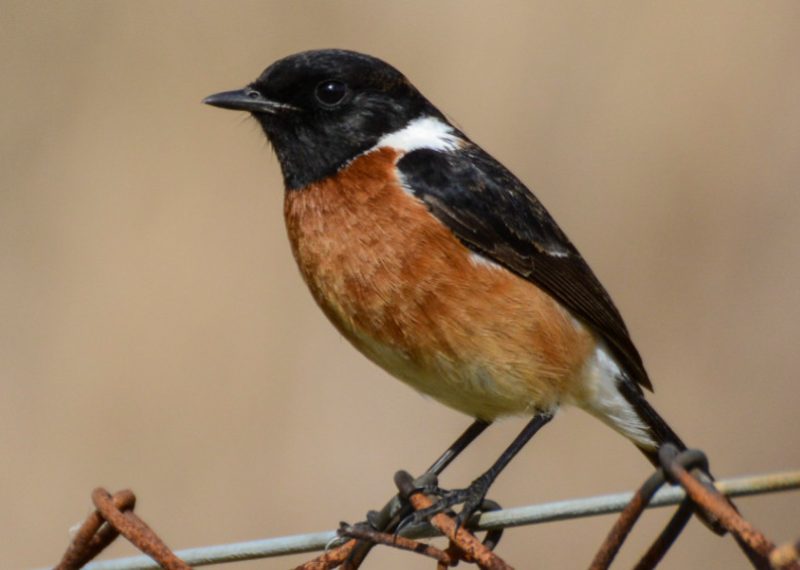
The African Stonechat (Saxicola torquatus) is a small yet agile bird, measuring 4.7–5.9 inches (12–15 cm) in length and weighing between 0.4 and 0.7 ounces (12–20 g). With a wingspan of 7.9–9.1 inches (20–23 cm), it typically lives for 2–3 years. Recognizable by its bright orange belly, chest, and distinctive white collar, it’s commonly found in open grasslands across Europe, Asia, and northern Africa.
Highly territorial, it perches atop bushes or low trees, using sharp vision to survey its surroundings. This vocal bird communicates through various calls, including alarm, contact, and courtship calls. Primarily insectivorous, it also consumes berries and fruits when insects are scarce, foraging on the ground and catching insects mid-air. Breeding from March to August, males attract mates through vocalizations and displays, while nests are constructed on the ground amid vegetation, with both parents sharing incubation and feeding duties for the chicks.
Red-breasted Nuthatch
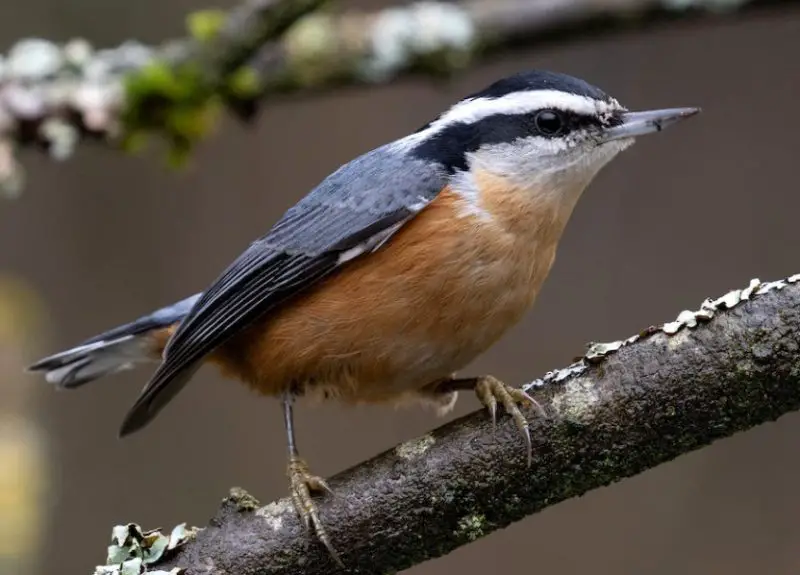
The Red-breasted Nuthatch (Sitta canadensis) is a small but dynamic bird recognized for its vibrant orange breast and blue-gray back. With a length ranging from 4.3 to 4.7 inches (11–12 cm) and weighing between 0.3 to 0.5 ounces (9–14 g), they navigate their environment with ease, aided by a wingspan of 7.9 to 9.8 inches (20–25 cm). These birds have a lifespan of 2 to 3 years and are found across North America, thriving in diverse habitats from coniferous forests to wooded suburbs.
Their remarkable agility in scaling trees vertically is supported by robust claws. While mainly insectivorous, they also relish seeds and nuts, storing them in bark crevices for winter. Their distinct “yank yank” calls resonate through forests, marking their presence.
Red-headed Woodpecker

The Red-headed Woodpecker (Melanerpes erythrocephalus) is a striking medium-sized bird, spanning 7.5–9.4 inches (19–24 cm) with a weight of 1.6–2.7 ounces (45–77 g) and a wingspan of 16.1–17.3 inches (41–44 cm). With a lifespan of 9–12 years, they boast a bright orange chest and a distinctive red head. Thriving across much of North America, they inhabit mature forests, suburbs, and parks, where they feed on insects, fruits, and seeds.
Their varied diet includes flying insects like beetles and grasshoppers, as well as fruits and berries such as elderberries and wild cherries. Known for their unique calls and aerial acrobatics, they are a sight to behold in the wild.
Allen’s Hummingbird
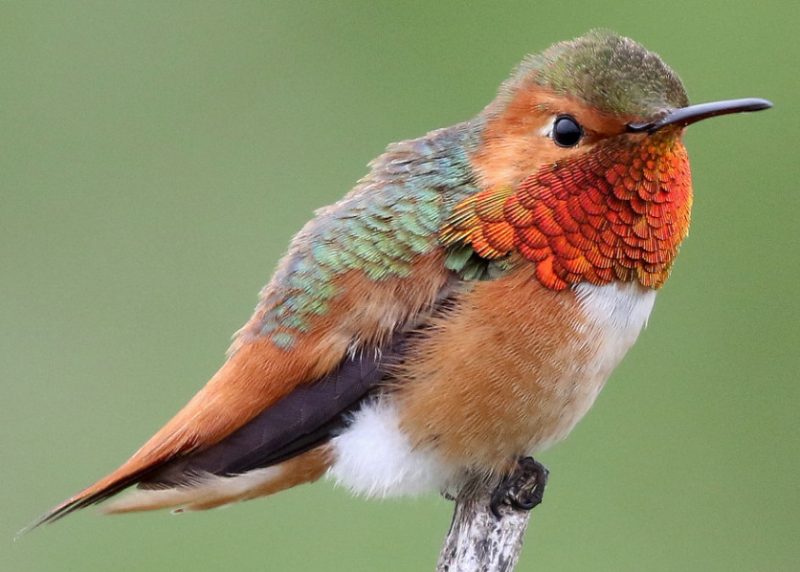
The Allen’s Hummingbird (Selasphorus sasin) is a petite marvel, measuring 3.5–4.3 inches (8.9–11 cm) in length and weighing 0.1–0.2 ounces (2.8–5.5 g), with a wingspan of 4.3–4.9 inches (11–12.4 cm). These vibrant birds boast bright orange chests and vibrant green backsides. Native to California and Baja California, they thrive in coastal scrub habitats abundant with flowering plants.
As adept nectar feeders, they play a crucial role in pollination, utilizing their long, slender bills. Despite their small size, they exhibit remarkable aerial acrobatics while feeding, darting and hovering with agility. Resilient creatures, Allen’s Hummingbirds can endure harsh environmental conditions, with a lifespan of 3–5 years.
Saffron Toucanet
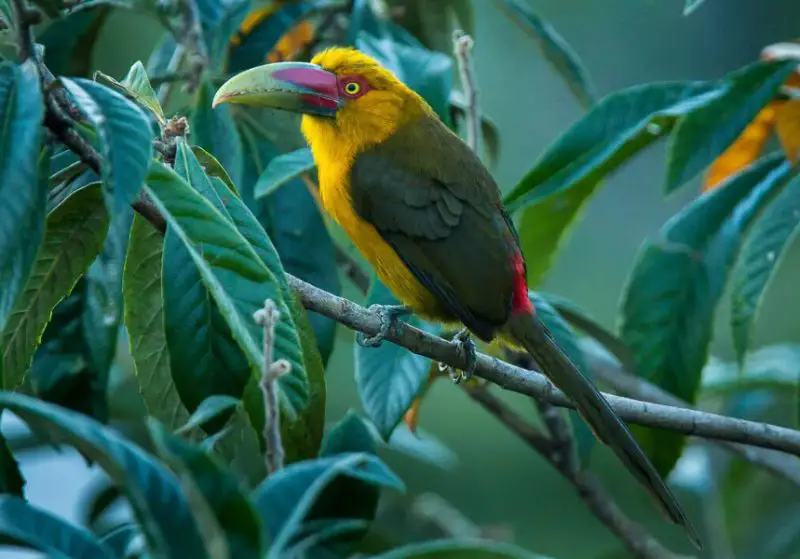
Pteroglossus bailloni, sometimes known as the Saffron Toucanet, is a species of bird that has a length of 11.8–13.4 inches (30–34 cm), a weight of 3.5–4.2 ounces (100–120 g), and a wingspan of 16.5–17.3 inches (42–44 cm). Wearing a rich orange abdomen and chest, they fit right in with the lush canopy of cloud forests in South and Central America.
With their strong bills, these nimble toucanets perform amazing acrobatics as they move between trees to smash open nuts and fruits. They have close social ties and frequently gather in tiny flocks, which increases their visibility and audibility. They play a major role in plant variety and the regeneration of forest ecosystems as essential seed dispersers. Their loud, raucous calls serve as distinct markers of their presence, facilitating flock communication and cohesion.
Baltimore Oriole
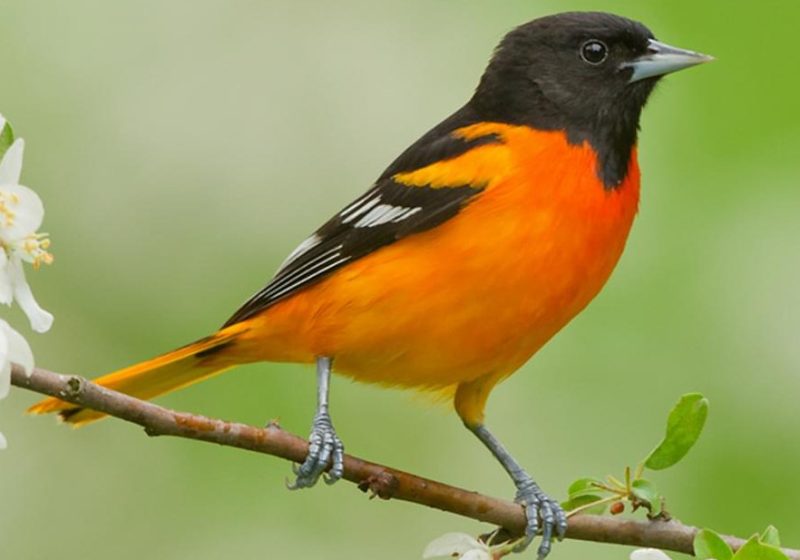
The Baltimore Oriole (Icterus galbula), showcases a striking appearance, measuring 7.5–8 inches (19–20 cm) in length and weighing 1.0–1.5 ounces (28–42 g). With a wingspan spanning 9–12 inches (23–30 cm), they display black and orange plumage, distinguishing them amidst avian species.
Their melodious songs resonate in various habitats, ranging from North America to Central and South America, while their diet comprises insects, fruits, and nectar. Tragically, habitat loss, pesticides, and climate variations pose significant threats to their survival.
Western Tanager
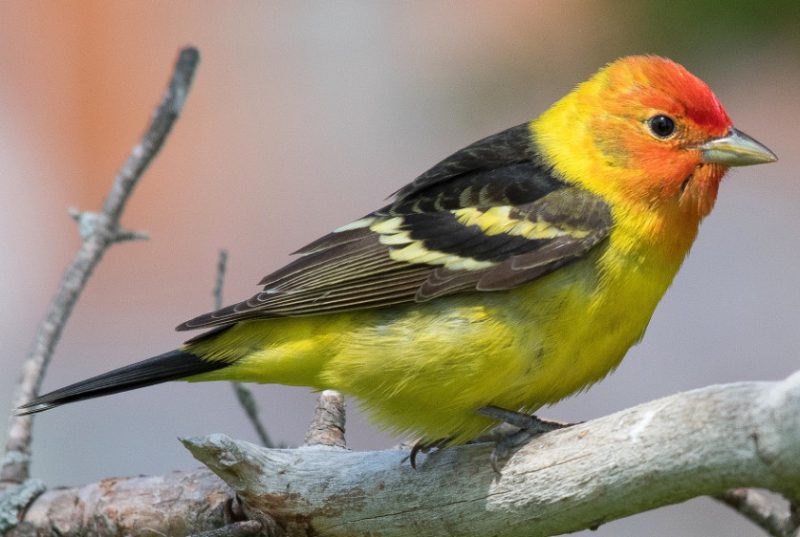
The striking red head of the Western Tanager (Piranga ludoviciana), which contrasts with its yellow wings, green back, orange breast, and yellow underparts, is what draws attention to this Least Concern species.
With a wingspan of 9–10.5 inches (23–27 cm) and an overall length of 6.5–7.5 inches (17–19 cm), they are common in coniferous woods on North America’s west coast. They weigh 0.6–0.9 ounces (17–26 g). Their voice adds to their attractiveness and their diet of wasps and bees makes them a favorite among birdwatchers.
Bullock’s Oriole
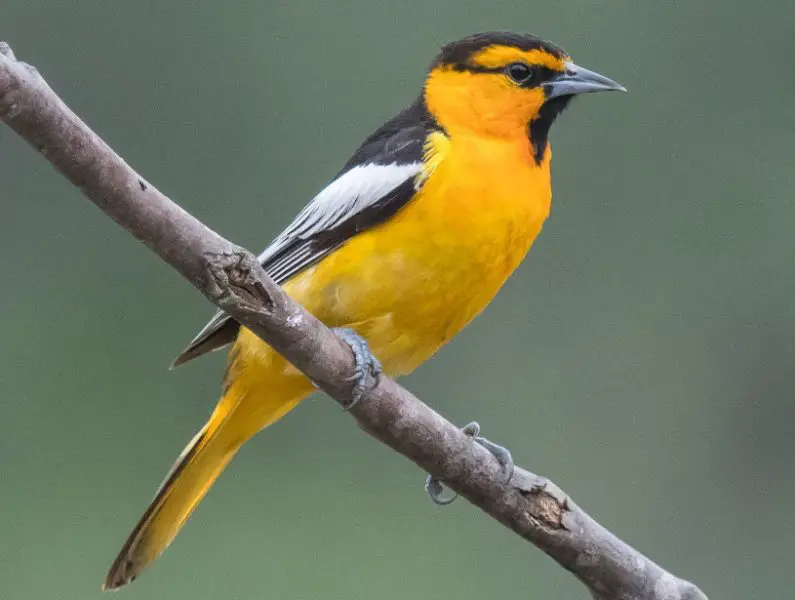
The Bullock’s Oriole (Icterus bullockii) graces the western half of America with its medium-sized body adorned in vibrant orange and black plumage, featuring an orange breast, black head, and back. Thriving in open woodlands and riparian areas, they sustain themselves on a diet of insects, nectar, and fruit.
The females’ skillfully woven hanging nests, constructed over 1 to 2 weeks using plant fibers and grasses, showcase remarkable avian craftsmanship. With a length ranging from 7 to 7.5 inches (18–19 cm), a weight of 1.0–1.2 ounces (28–34 g), and a wingspan of 11–13 inches (28–33 cm), they typically live for 5–7 years.
Hooded Oriole

The orange chest of the Hooded Oriole (Icterus cucullatus) draws attention to its striking black and yellow feathers. They are abundant in riparian zones and open forests, where they feed on insects, fruit, and nectar. They painstakingly weave plant fibers into basket-like nests, which they build in palm trees. Birdwatchers are delighted when they hear their beautiful mating song filling their area.
It’s fun to watch them at backyard feeders, their vivid colors sparkling in the sunlight. They usually live for 4-5 years. They are 7–7.5 inches (18–19 cm) long, 0.7–1.0 ounces (20–28 g) in weight, and have a wingspan of 10–12 inches (25–30 cm).
Scarlet Tanager
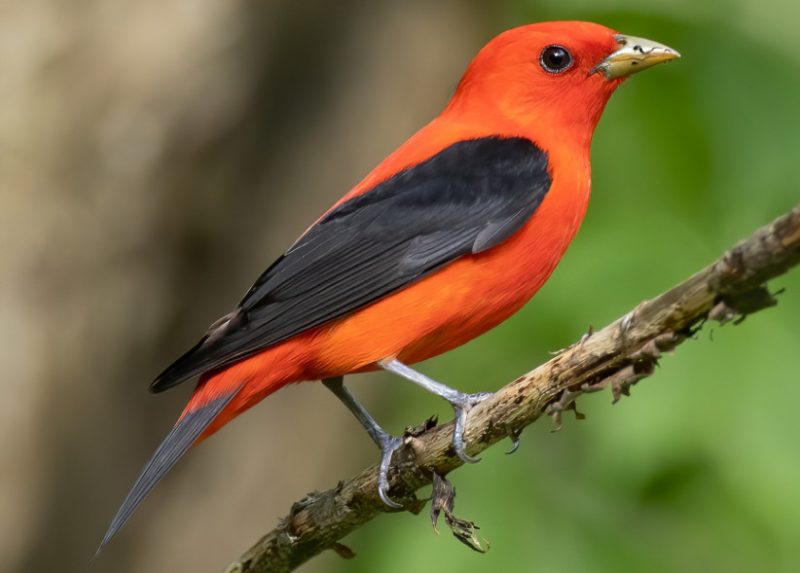
The Scarlet Tanager, or Piranga olivacea, is a bird with vivid red plumage, black wings and tail, and an orange chest. It is 6.5–7.5 inches (17–19 cm) long and weighs 0.8–1.1 ounces (23–32 g). During mating seasons, they are found in the deciduous forests of eastern North America, where they prefer unaltered environments.
They are a favorite summertime birdwatching emblem, entertaining with their characteristic short, rapid notes while feeding on insects, fruit, and sometimes nectar. Their distinct cup-shaped nests inside the forks of tree branches add to their attraction.
Belted Kingfisher
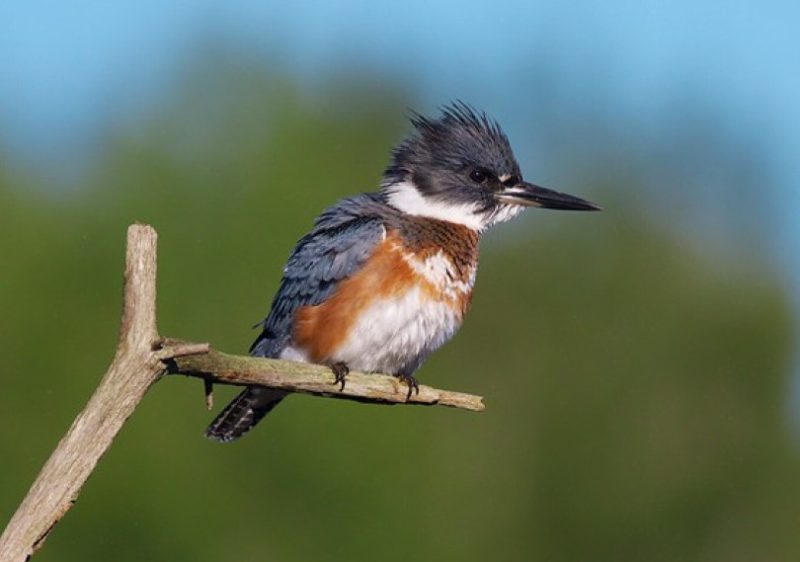
The Belted Kingfisher (Megaceryle alcyon), with a length ranging from 11.8 to 13.4 inches (30–34 cm) and a weight of 4.6–6.7 ounces (130–190 g), is a striking bird with a shaggy crest, deep blue plumage, and vibrant orange chest.
Found across North America near water bodies, they dive headfirst to catch fish with their long, pointed bills. Their distinctive rattling calls echo over their territories, showcasing remarkable hunting precision.
Flame Robin
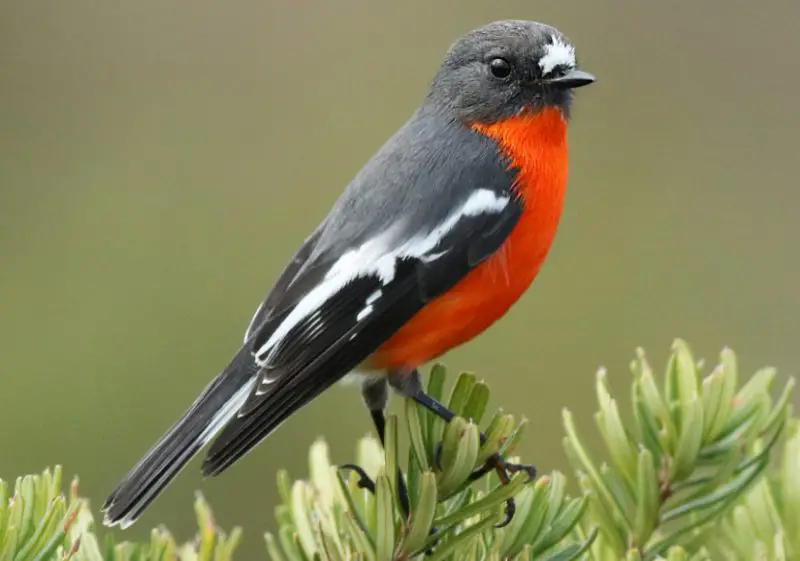
The Flame Robin (Petroica phoenicea), measuring 4.7–5.5 inches (12–14 cm) in length and weighing 0.5–0.6 ounces (14–18 g), is a visually striking bird with fiery orange underparts and distinctive black and white wings. Found mainly in southeastern Australia, they inhabit open woodland and grassland areas.
Primarily insectivorous, they feed on insects and small invertebrates, often catching prey by perching on trees or low bushes and swooping down. Additionally, they are known for their sweet, melodious songs.
Rufous-tailed Jacamar
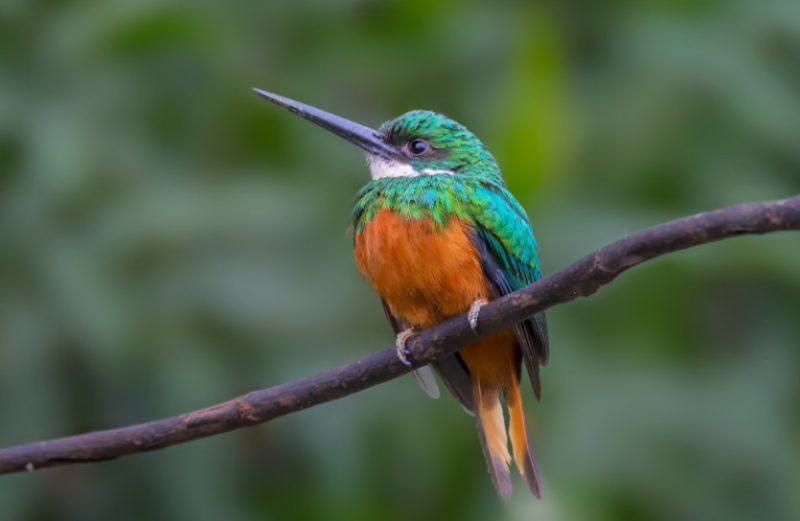
The Rufous-tailed Jacamar (Galbula ruficauda), spanning 8.3–9.4 inches (21–24 cm) in length and weighing 1.5–1.7 ounces (42–48 g), is a striking bird native to the tropical regions of South and Central America. Renowned for its vivid orange belly, iridescent green back, and long rufous tail, it thrives in humid forests.
A skilled hunter, it preys on insects, spiders, and small lizards, capturing them with remarkable precision in mid-air. Its dazzling appearance and adept hunting prowess make it a cherished sight for birdwatchers.
Golden-breasted Starling
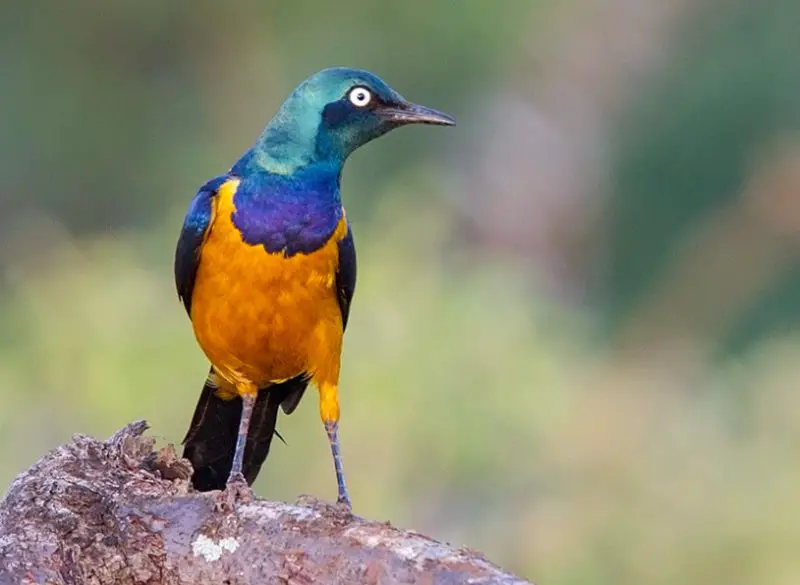
The Golden-breasted Starling (Lamprotornis regius), measuring 7.5–8.3 inches (19–21 cm) in length and weighing 1.9–2.1 ounces (54–60 g), is a bird found across Africa. Its stunning golden-orange chest and glossy black back make it a remarkable sight.
Often found in trees and bushes, they exhibit social behavior, flocking in groups and engaging in vocalizations, preening, and feeding. Their diverse diet includes fruits, seeds, and insects, contributing to their ecosystem.
Rose-breasted Cockatoo

The Rose-breasted Cockatoo, scientifically known as Eolophus roseicapilla, measures 14–16 inches (35–40 cm) in length and weighs 17.6–19.8 ounces (500–560 g), with a wingspan of 20.9–23.2 inches (53–59 cm). With its stunning pinkish-orange and grey plumage, this Australian native parrot has become a beloved pet worldwide.
It exhibits playful and affectionate behavior, forming strong bonds with owners. However, wild populations face threats from habitat loss, hunting, and illegal capture, necessitating conservation efforts.
Common Pheasant
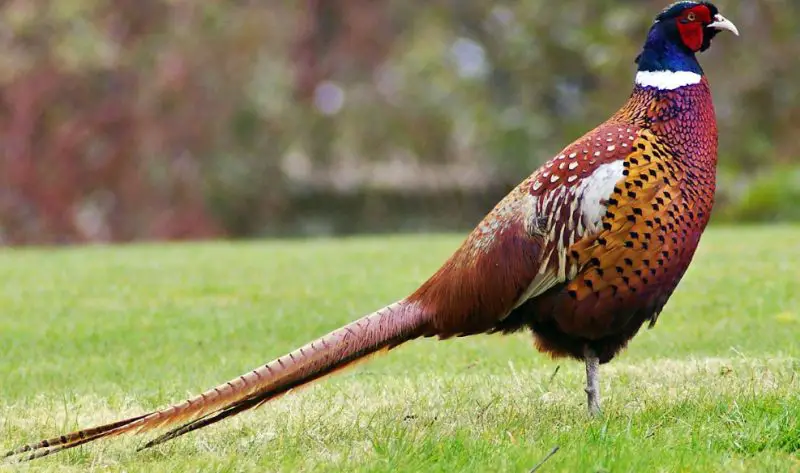
The Common Pheasant, scientifically known as Phasianus colchicus, boasts impressive dimensions, measuring 22–35 inches (55–90 cm) in length, weighing 2.2–3.3 ounces (65–94 g), with a wingspan of 27.6–35.4 inches (70–90 cm). Esteemed for both its beauty and as a game bird, it has a lifespan of 3–4 years. With vibrant plumage and ornamental value, it has become a symbol of hunting traditions worldwide.
Vermilion Flycatcher
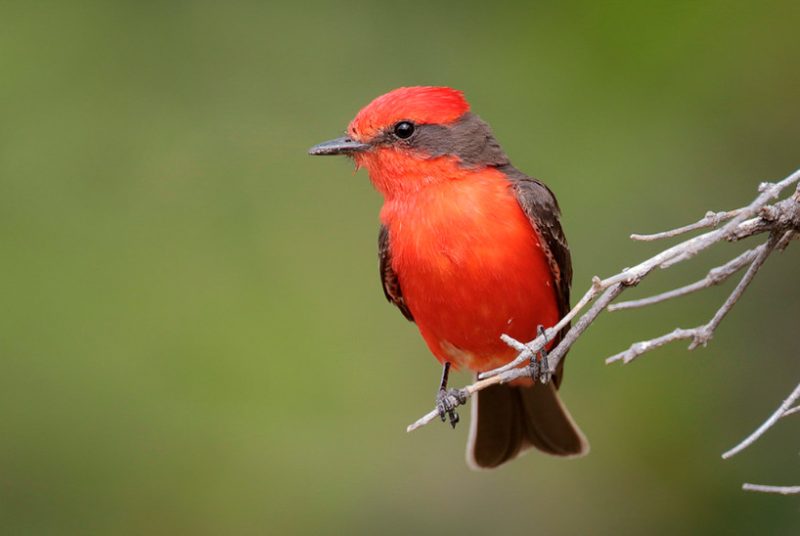
The Vermilion Flycatcher, scientifically known as Pyrocephalus rubinus, is a small bird with vibrant plumage native to the Americas. Measuring 4.3–5.1 inches (11–13 cm) in length and weighing 0.28–0.45 ounces (8–13 g), it boasts fiery-orange feathers contrasting with brown wings.
Found in grasslands and deserts, it primarily feeds on insects. With a lifespan of 3–4 years, it captivates birdwatchers and aviculturists alike.
Eastern Bluebird

The Eastern Bluebird, scientifically known as Sialia sialis, is a stunning bird native to eastern North America. Measuring 6.3–8.3 inches (16–21 cm) in length and weighing 0.95–1.1 ounces (27–30 g), it boasts vibrant blue feathers on its back and wings. With a wingspan of 9.8–12.2 inches (25–31 cm) and a lifespan of 6–10 years, it’s a welcome sight for bird enthusiasts.
These cavity nesters often utilize man-made nest boxes for breeding and contribute to insect control with their omnivorous diet.
Orange-breasted Sunbird
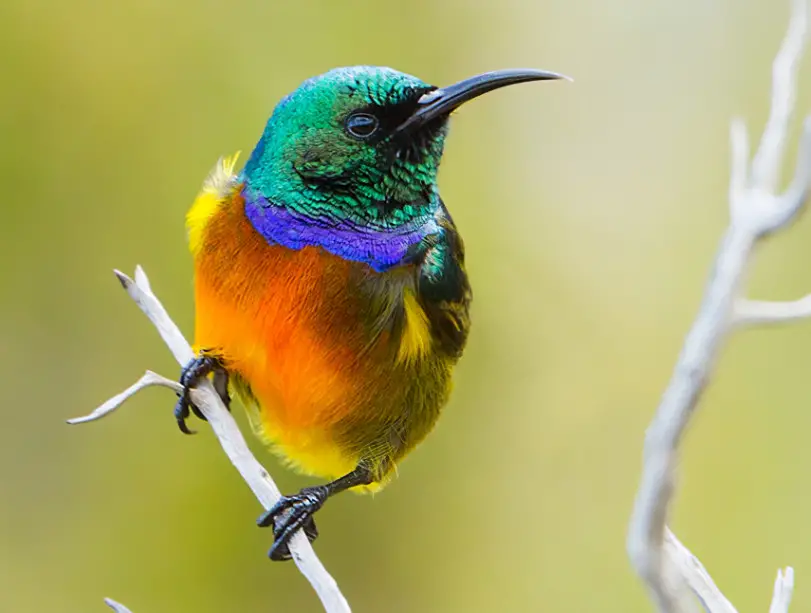
The Orange-breasted Sunbird (Anthobaphes violacea) is a stunning bird native to Southern Africa, measuring 3.9–4.7 inches (10–12 cm) in length and weighing 0.15–0.21 ounces (4–6 g). Males boast iridescent green feathers, while females are less vibrant.
With a wingspan of 4–6 inches (10–15 cm) and a lifespan of 16–22 years, they play a vital role as pollinators, contributing to ecosystem health. Conservation efforts are essential to safeguard their habitats and populations.
African Pygmy Kingfisher
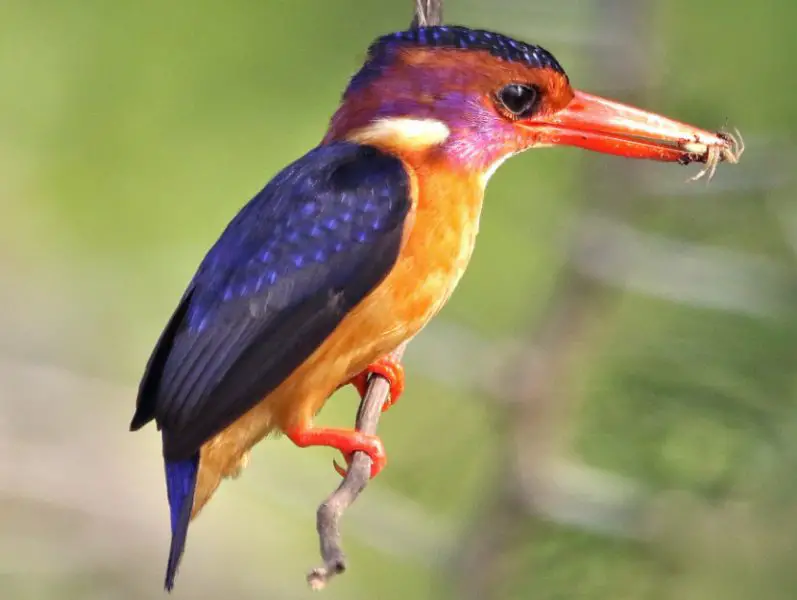
The African Pygmy Kingfisher, scientifically known as Ispidina picta, is a marvel of nature. Measuring just 4.3–4.7 inches (11–12 cm) in length and weighing 0.35–0.37 ounces (10–11 g), this tiny bird boasts a wingspan of 6.3–7.1 inches (16–18 cm). Despite its small size, it displays vibrant plumage, with bright blue feathers on its back, wings, and tail, complemented by an orange-brown breast and white belly.
With a lifespan of 4–6 years, this charming avian species exhibits remarkable aerial agility as it hunts insects and small invertebrates from perches. Though facing threats like habitat loss and climate change, ongoing conservation efforts provide hope for its preservation.
Collared Sunbird
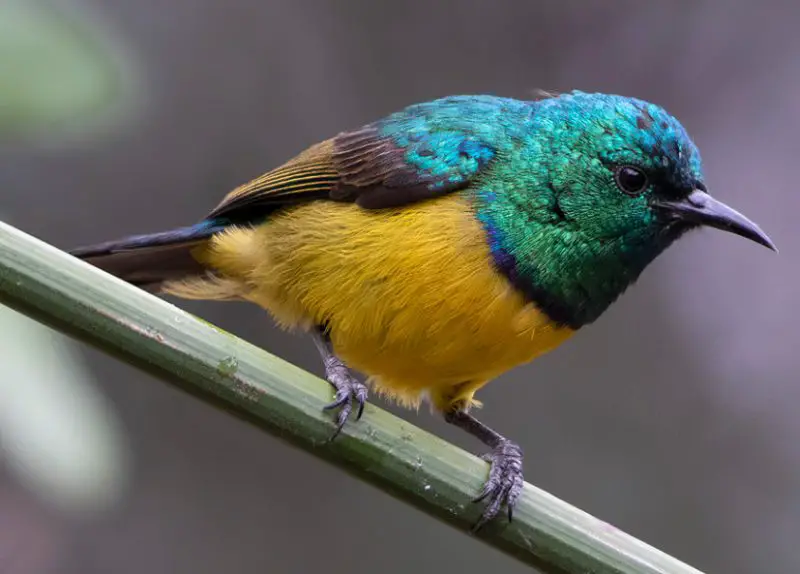
The Collared Sunbird, scientifically named Hedydipna collaris, is a petite and colorful bird indigenous to eastern and southern Africa. With males showcasing iridescent blue-green feathers on their backs and bright red breasts adorned with a distinctive white collar, and females displaying iridescent green plumage, they play a crucial role in pollination as essential nectar feeders.
Despite facing threats such as habitat loss and climate change, these resilient birds thrive in diverse habitats, ranging from forests to gardens, with a lifespan of 5–6 years.
Northern Flicker
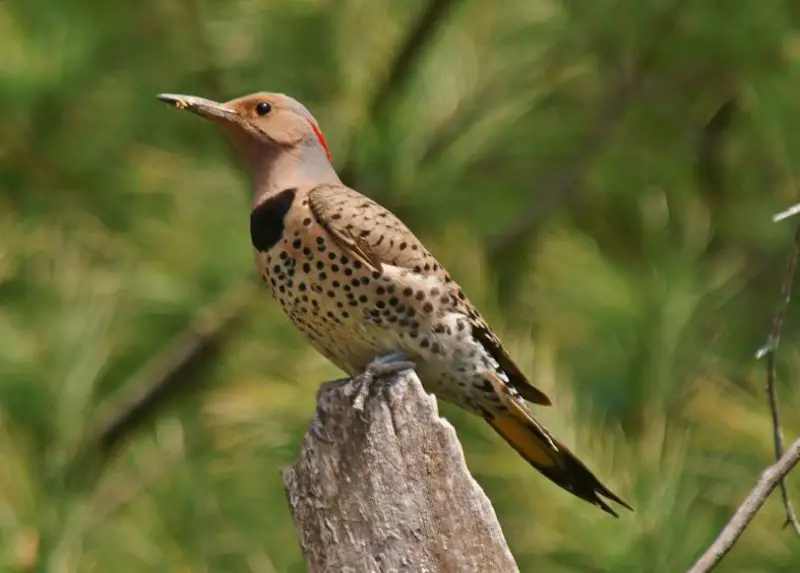
The Northern Flicker, scientifically known as Colaptes auratus, is a medium-sized woodpecker native to North America. Sporting a distinctive black and white barred pattern on their back and wings, along with a red patch on their nape, they exhibit light orange undersides on their wings, chests, and tail feathers.
Northern Flickers are insectivorous, often foraging for ants and beetles on the ground, although they also consume berries and seeds. As cavity nesters, they utilize both natural and manufactured nest boxes. These birds serve as essential indicators of forest health, sensitive to habitat fragmentation and changes in forest structure, and typically have a lifespan of 4–9 years.
Western Bluebird
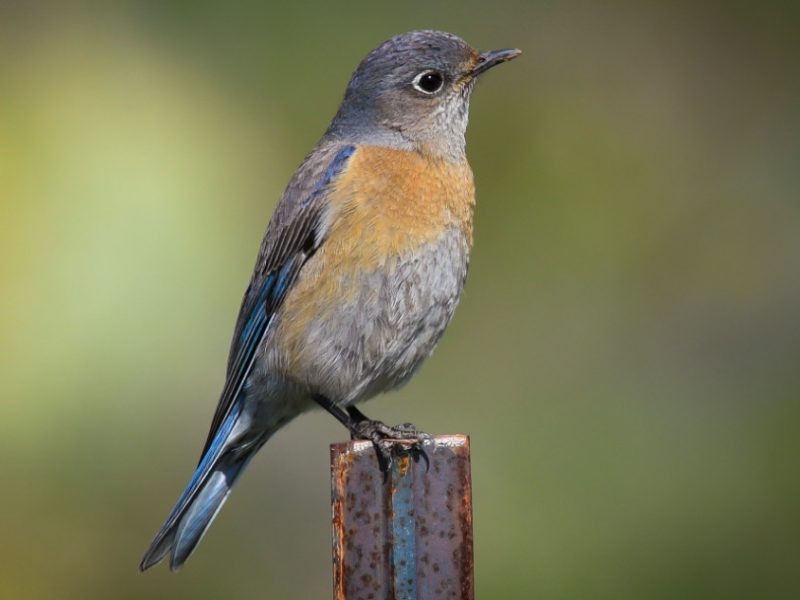
The Western Bluebird, scientifically known as Sialia mexicana, enchants observers in the Western United States with its vibrant plumage and melodious songs. These petite birds, weighing between 1.1 and 1.3 ounces, sport blue feathers and orange breasts. While males boast brighter hues, females exhibit gray-blue tones.
With a wingspan ranging from 12.2 to 15.0 inches and a lifespan of 5–7 years, they nest in tree cavities or boxes, contributing to the biodiversity of their habitat.
Black-capped Chickadee
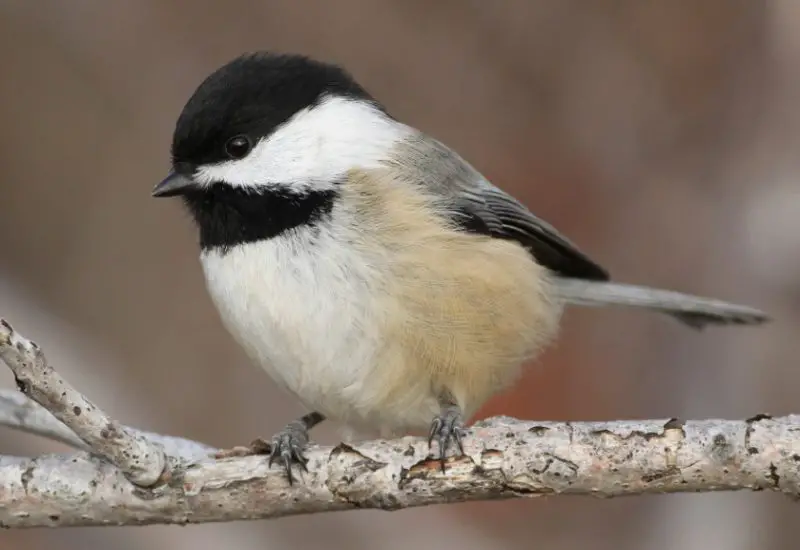
The Black-capped Chickadee, scientifically named Poecile atricapillus, is a beloved sight across North America. With its distinctive black cap, white cheeks, and gray wings, it measures between 4.7 and 5.9 inches and weighs 0.28 to 0.49 ounces. Sporting a wingspan of 6.3 to 8.3 inches and a lifespan of 2–3 years, this sociable bird is known for its fearless nature and unique vocalizations.
Adaptable and curious, it thrives in various habitats, captivating birdwatchers with its active presence and memory-based food caching behavior.
Spot-breasted Oriole
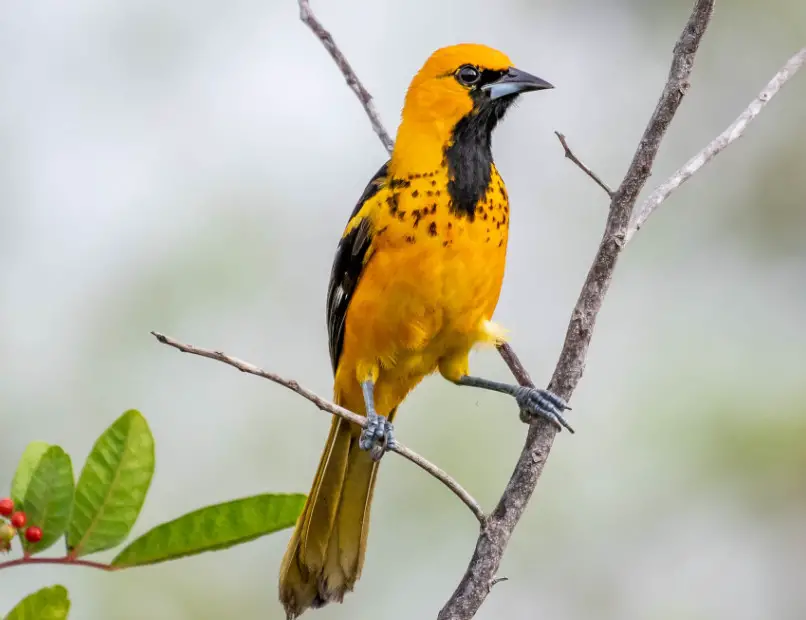
The Spot-breasted Oriole (Icterus pectoralis) is a striking bird found in Central and South America. With lengths ranging from 7.5 to 8.3 inches and weights of 1.4 to 1.8 ounces, these birds sport vibrant orange-yellow heads and breasts contrasting with black backs and wings.
Living up to 8–10 years, they prefer open woodlands and gardens, where their sweet, soft tones and pendulous nests add to their beauty. Highly adaptable, they thrive in urban areas, delighting birdwatchers with their beauty and melodies.
Coppery-chested Jacamar
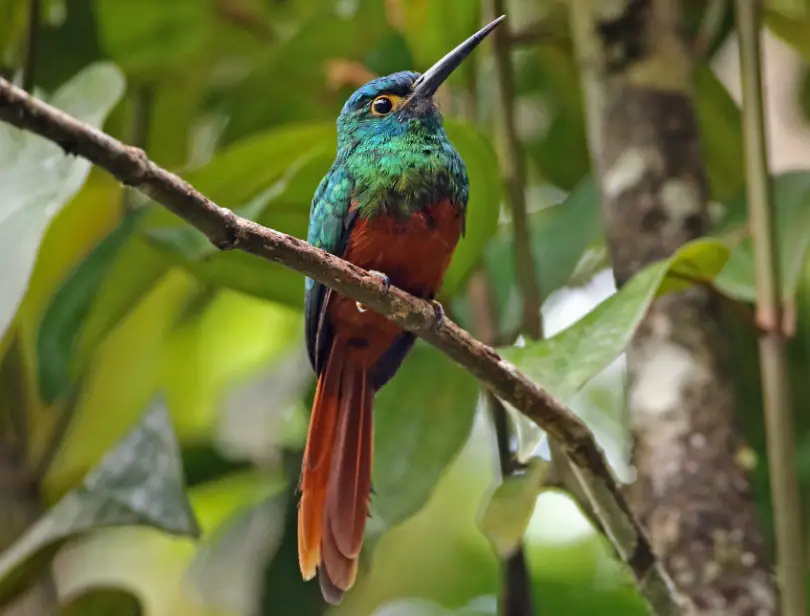
The Coppery-chested Jacamar (Galbula pastazae) is a striking bird found in Central and South American rainforests. It measures 6.3–6.7 inches (16–17 cm) in length and weighs 0.9–1.0 ounces (25–28 g), with a wingspan of 7.9–8.7 inches (20–22 cm). Males boast a bright coppery-orange chest, while females have more subdued tones.
With a preference for dense canopies, they hunt insects by perching and waiting. Their distinct low-pitched trill echoes through the forest. With a lifespan of 6–8 years, they contribute to the vibrant ecosystem of the rainforest.
Western Spindalis
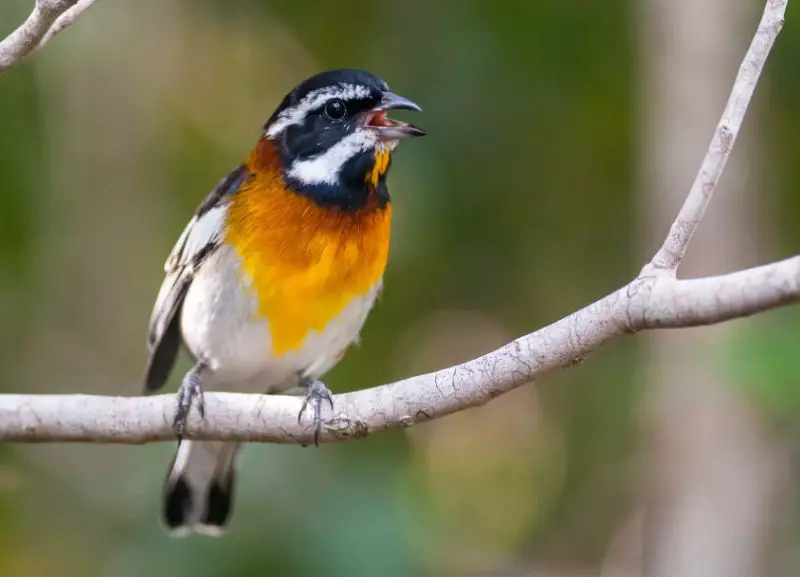
The Western Spindalis (Spindalis zena) is a magnificent bird found in the Caribbean islands and parts of Central and South America. With a length of 5.5–6.7 inches (14–17 cm) and a weight of 0.53–0.7 ounces (15–20 g), they exhibit vibrant yellow heads and bright orange patches. Female Western Spindalis sport a more subdued green hue.
Preferring open woodlands and gardens, they feed on insects and fruit, showcasing their sweet and varied song. Their nests, built in trees, highlight their intelligence and resourcefulness, adding to their allure.
Barn Swallow
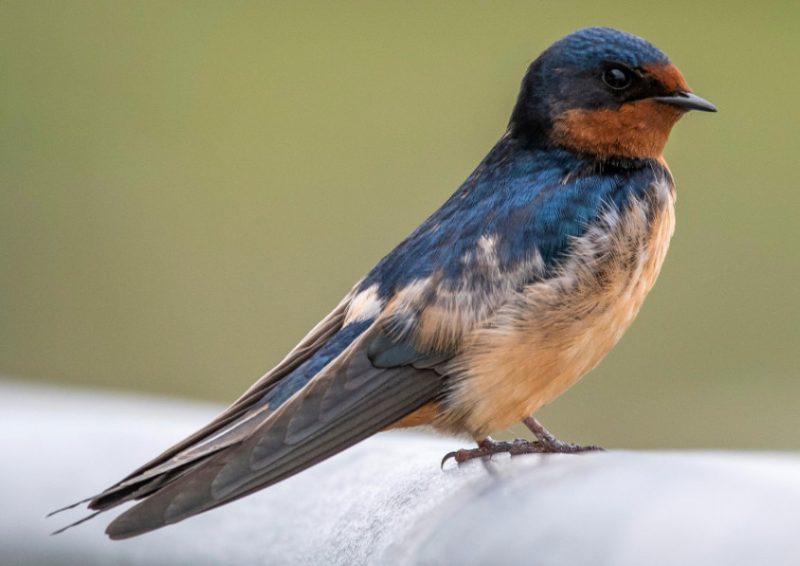
The Barn Swallow (Hirundo rustica) is a beloved bird renowned for its aerial prowess and distinctive appearance. With a length of 6.7–7.5 inches (17–19 cm) and a weight of 0.56–0.78 ounces (16–22 g), it flaunts a blue-black back and wings, contrasting with its rust-colored throat, forehead, and orange belly.
Preferring open habitats, it feeds primarily on insects and contributes to natural pest control. Its mud nests, built against vertical surfaces, showcase its resourcefulness. With a lifespan of 4–7 years, its graceful flight and sweet songs captivate observers.
American Robin
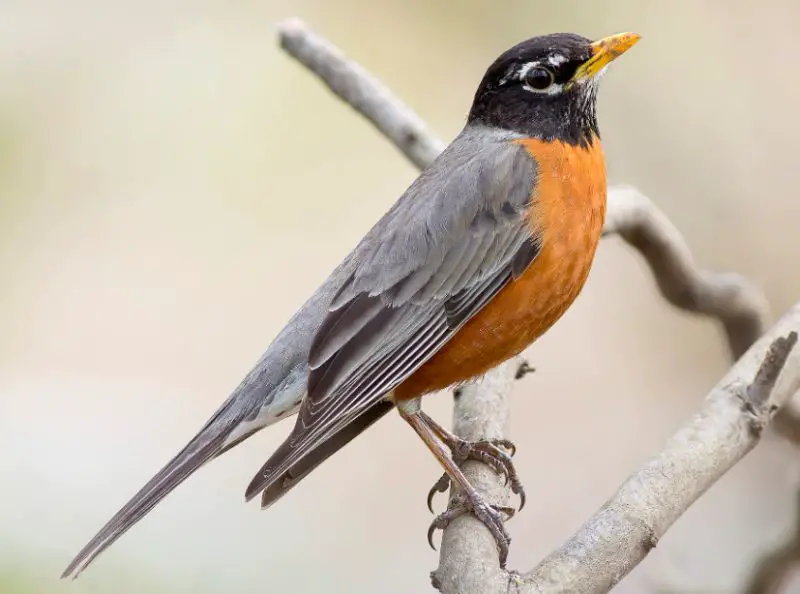
The American Robin (Turdus migratorius) is a widespread songbird in North America, known for its iconic orange breast and grey-brown back. Often found in woodlands, parks, and gardens, these birds have a varied diet, including insects, fruit, and worms.
With a wingspan of 14–16 inches (36–41 cm) and a lifespan of up to 2 years, American Robins delight observers with their melodious tones and unique nesting habits, often utilizing mud, grass, and twigs in their constructions.
Red Knot
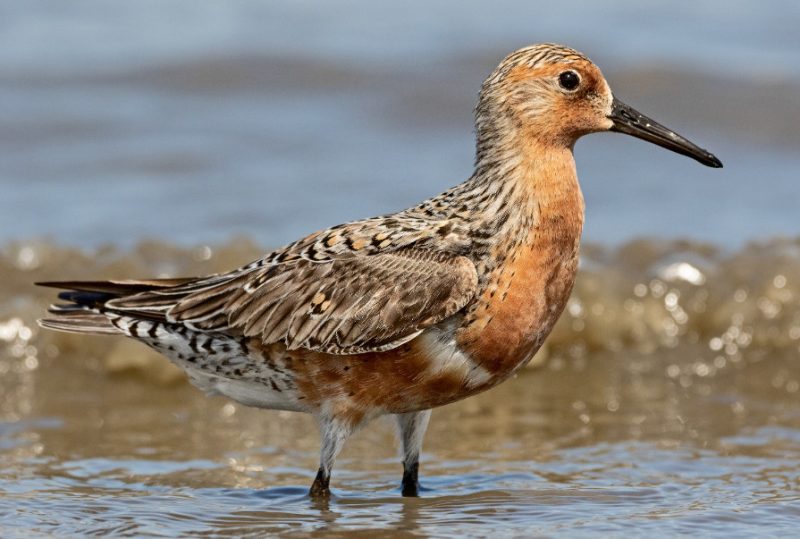
The Red Knot (Calidris canutus), classified as Near Threatened, is a shorebird with distinctive features. Measuring 9–11 inches in length and weighing 3.5–6.7 ounces, it boasts a wingspan of 20–22 inches. Typically found along North American coasts, it feeds on mollusks and crustaceans, utilizing its specialized bill.
With conservation efforts imperative due to habitat loss and hunting, preserving its population is crucial for its longevity, which can reach up to 10 years.
American Woodcock
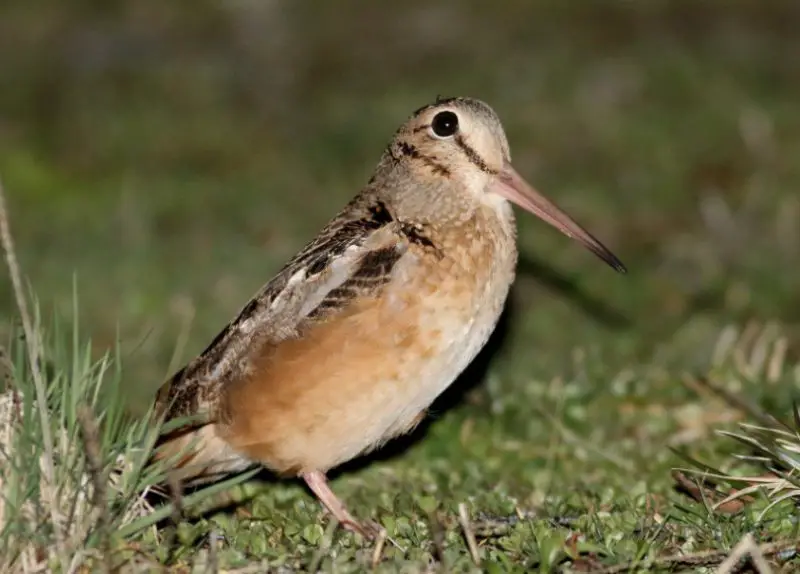
The American Woodcock (Scolopax minor), colloquially known as the timberdoodle, is an intriguing bird species found in eastern North America. With a length of 10–12 inches and weighing 5–8 ounces, it boasts a wingspan of 16–17 inches. Thriving in damp, brushy forests, these birds utilize their long, straight bills to forage for earthworms and insects.
Their elaborate courtship displays contribute to successful breeding, while conservation efforts aim to protect them from habitat loss and hunting pressures.
Orange-breasted Waxbill
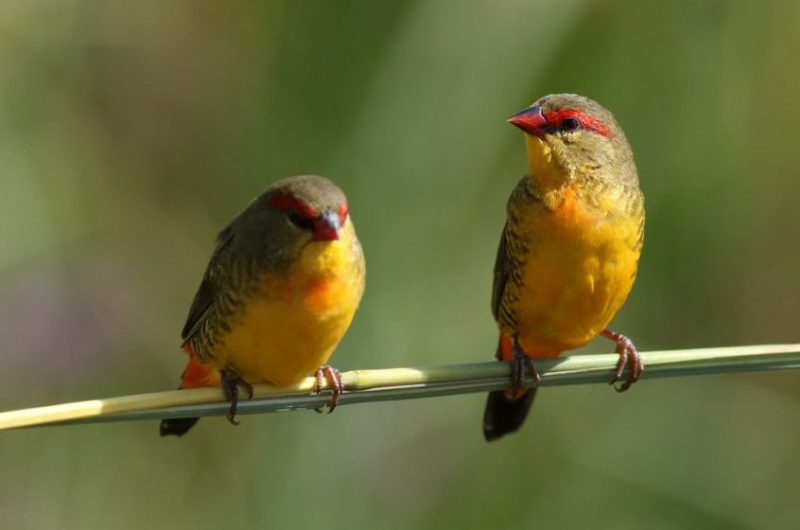
The Orange-breasted Waxbill (Amandava subflava), is a small African bird known for its vibrant orange breast and contrasting black back. These social birds, often found in flocks of up to 20 individuals, prefer habitats such as open grasslands and savannas.
During courtship, males engage in elaborate displays accompanied by melodious chirps. Females construct nests made of grass and feathers for breeding, typically near the ground. In captivity, they flourish on a diet consisting of seeds and fresh produce. With a lifespan of 5-7 years, these waxbills contribute to the biodiversity of their ecosystems.
Black-faced Waxbill
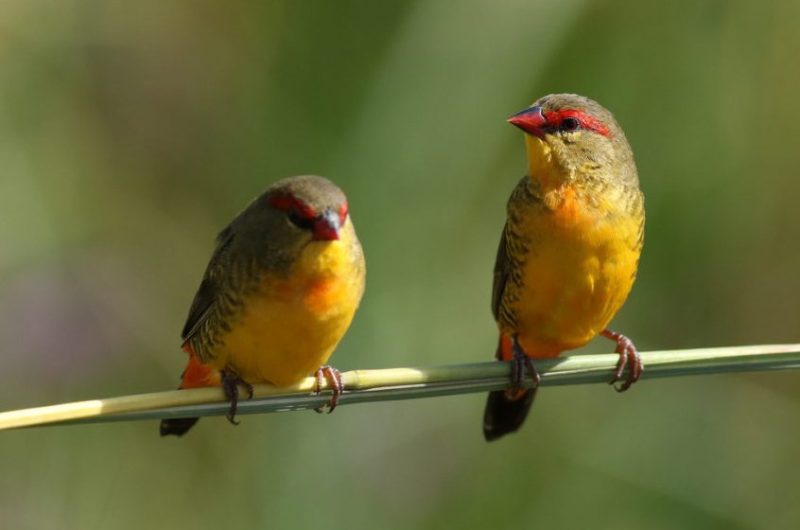
The Black-faced Waxbill (Estrilda erythronotos), categorized as Least Concern, is an African avian species with a distinctive appearance. With a length ranging from 4.0 to 4.3 inches and weighing between 0.21 to 0.31 ounces, it’s a small bird with a wingspan of 6.7 to 7.5 inches.
These finches primarily consume Niger and sunflower seeds and are characterized by males’ vibrant orange breast patches, potentially playing a role in courtship. Typically, they live for 4-5 years.
Cooper’s Hawk

The Cooper’s Hawk (Accipiter cooperii) is a formidable predator, adorned with a orange belly and chest set against a blue-grey back. Spanning 14–20 inches and weighing 7–24 ounces, with a wingspan of 28–36 inches, they dominate the skies of North America.
Thriving in wooded habitats, they showcase remarkable agility and sharp talons, employing stealthy tactics to hunt prey. Even backyard bird feeders may witness their prowess, underscoring their adaptability and formidable presence.
Rufous Hummingbird

The Rufous Hummingbird (Selasphorus rufus) is a diminutive marvel, featuring a vibrant orange-red chest and an iridescent green back within its 3.1–3.7 inches and 0.1–0.3 ounces. Renowned for remarkable migrations, spanning Western North America to Mexico, they traverse thousands of miles annually. Their courtship is equally impressive, involving high-speed dives accompanied by whistling sounds to woo females.
These agile birds are crucial pollinators, unintentionally aiding plant reproduction through pollen transfer. Preferring flowers with red or orange hues, Rufous Hummingbirds contribute significantly to their ecosystem’s vibrancy and vitality throughout their 3–5-year lifespan.
Brown-headed Cowbird
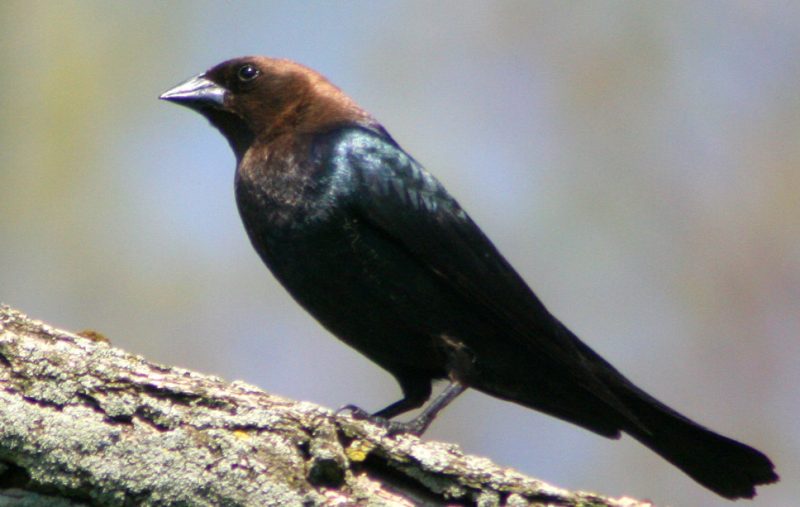
The Brown-headed Cowbird (Molothrus ater) is a medium-sized bird with a distinctive brown head and glossy black body, measuring 12.2–13.4 inches and weighing 2.8–4.9 ounces. Males sport a notable brownish-orange patch on their chests, contrasting with their glossy black plumage.
These opportunistic feeders adapt well to various environments, often following grazing animals to feed on insects and seeds. Their striking appearance and adaptable nature make them stand out in their habitats, with a lifespan of 6–10 years.
People Who Read This Also Read:

